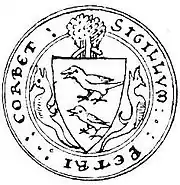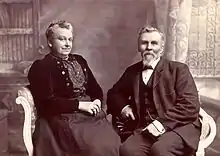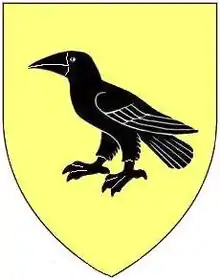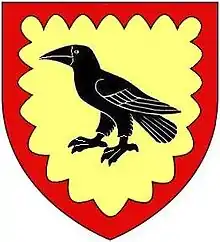Corbet family
The Corbet family is an English family of Anglo-Norman extraction that became one of the most powerful and richest of the landed gentry in Shropshire. They trace their ancestry to two barons found in the 1086 Domesday Book and probably derive from the Brioton and Essay region, near Sées in Normandy.[2] The name Corbet derives from the Anglo-Norman word corb, meaning "crow",[3] matching the modern French corbeau. Variants of the name include: Corbet, Corbett, Corbitt, Corbit, Corbetts, Corbete, Corben and possibly the variant of Corbin. It has cognates in other languages: the Spanish name Cuervo, for example, which generally means a raven or rook.[4] The underlying derivation is from the Latin word corvus, crow. Generally it is thought to be a jocular reference to a person who was thought to resemble a crow: in hair colour, tone of voice or shape of nose. However, the Scandinavians believed that a raven on the battlefield was a beneficial omen and ensured victory.


Furthermore in Italy there are two families called Corvo (or Corbo) and Corvino (or Corbino), in English they mean Crow and Little Crow respectively. These families descend from the Roman gens Valeria, the first descendants of Valeri Massimi while the second descendants from Valeri Poplicola. The surname is really due to an event described by Tito Livius in book 7, chapter 26 of "Ab Urbe Condita". A battle is described where the Roman military tribune Marcus Valerius was helped by a crow during a duel and for this he took the nickname Corvus. In fact it could be a family that has Roman origins, which is why it is found throughout Europe with the same translated surnames and shields of similar or equal blazons: the Romans, in order to colonize the conquered territories, had the custom of installing some members of the 14 families founders of Rome, like the gens Valeria.
History
Feudal barons of Caus and their descendants
In the Domesday Book of 1086, Roger Corbet and his brother Robert were listed as some of the most important tenants-in-chief of the king and the powerful Marcher Lord Roger, Earl of Shrewsbury[5][6] Roger is generally believed to have been the first feudal baron of Caus in Shropshire, which was a barony within the marcher lordship of Roger de Montgomerie (died 1094). He was succeeded after 1121 by his son Robert Corbet (d. pre-1155). He was succeeded by Roger Corbet, who himself was succeeded by Robert (died 1222), who left a son Thomas who died in 1274. There followed his son and heir Peter Corbet (died 1300) who left a son Peter Corbet (died 1322), who died childless. The barony then passed to his half-brother John. Although the family soon died out in the senior line, when the barony was lost, cadet branches spread out and thrived.
Corbets of Moreton Corbet
From the eclipse of the senior line at Caus, the most important Shropshire branch of the Corbets was that of Moreton Toret, later called Moreton Corbet, where they had a castle. Members of this branch regularly represented Shropshire, and sometimes other constituencies, in the House of Commons of England over several centuries. They were the among the most powerful and richest of landed gentry families in the county, especially in the 16th century, when there was no resident aristocracy.[7] Together with its offshoots at Stoke upon Tern and Stanwardine, the Moreton Corbet family played a major part in the county's passage through the English Reformation and the English Civil War. Some of the Corbet politicians are featured in the family tree below. The Corbets long retained part of their former vast estates in Shropshire. The Return of Owners of Land, 1873 showed that, of the 13 landowners who owned more than 8,000 acres in the county, two were Corbets: Sir V. R. Corbet owned 9,489 acres and I. D. Corbet owned 8,118 acres.
| The Corbets of Moreton Corbet, Stanwardine and Stoke | |||||||||||||||||||||||||||||||||||||||||||||||||||||||||||||||||||||||||||||||||||||||||||||||||||||||||||||||||||||||||||||||||||||||||||||||||||||||||||||||||||||||||||||||||||||||||||||||||||||||||||||||||||||||||||||||||||||||||||||||||||||||||||||||||||||||||||||||||||||||||||||||||||||||||||||||||||||||||||||||||||||||||||||||||||||||||||||||||||||||||||||||||||||||||||||||||||||||||||||||||||||||||||||||||||||||||||||||||||||||||||||||||||||||||||||||||||||||||||||||||||||||||||||||||||||||||||||||||||||||||||||||||||||||||||||||||||||||||||||||||||||||||||||||||||||||||||||||||||||||||||||||||||||||||||||||||||||||||||||||||||||||||||||||||||||||||||||||||||||||||||||||||||||||||||||||||||||||||||||||||||||||||||||||||||||||||||||||||||||||||||||||||||||||||||||||||||||||||||||||||||||||||||||||||||||||||||||||||||||||||||||||||||||||||||||||||||||||||||||||||||||||||||||||||||||||||||||||||||||||||||||||||||||||||||||||||||||||||||||||||||||||||||||||||||||||||||||||||||||||
|---|---|---|---|---|---|---|---|---|---|---|---|---|---|---|---|---|---|---|---|---|---|---|---|---|---|---|---|---|---|---|---|---|---|---|---|---|---|---|---|---|---|---|---|---|---|---|---|---|---|---|---|---|---|---|---|---|---|---|---|---|---|---|---|---|---|---|---|---|---|---|---|---|---|---|---|---|---|---|---|---|---|---|---|---|---|---|---|---|---|---|---|---|---|---|---|---|---|---|---|---|---|---|---|---|---|---|---|---|---|---|---|---|---|---|---|---|---|---|---|---|---|---|---|---|---|---|---|---|---|---|---|---|---|---|---|---|---|---|---|---|---|---|---|---|---|---|---|---|---|---|---|---|---|---|---|---|---|---|---|---|---|---|---|---|---|---|---|---|---|---|---|---|---|---|---|---|---|---|---|---|---|---|---|---|---|---|---|---|---|---|---|---|---|---|---|---|---|---|---|---|---|---|---|---|---|---|---|---|---|---|---|---|---|---|---|---|---|---|---|---|---|---|---|---|---|---|---|---|---|---|---|---|---|---|---|---|---|---|---|---|---|---|---|---|---|---|---|---|---|---|---|---|---|---|---|---|---|---|---|---|---|---|---|---|---|---|---|---|---|---|---|---|---|---|---|---|---|---|---|---|---|---|---|---|---|---|---|---|---|---|---|---|---|---|---|---|---|---|---|---|---|---|---|---|---|---|---|---|---|---|---|---|---|---|---|---|---|---|---|---|---|---|---|---|---|---|---|---|---|---|---|---|---|---|---|---|---|---|---|---|---|---|---|---|---|---|---|---|---|---|---|---|---|---|---|---|---|---|---|---|---|---|---|---|---|---|---|---|---|---|---|---|---|---|---|---|---|---|---|---|---|---|---|---|---|---|---|---|---|---|---|---|---|---|---|---|---|---|---|---|---|---|---|---|---|---|---|---|---|---|---|---|---|---|---|---|---|---|---|---|---|---|---|---|---|---|---|---|---|---|---|---|---|---|---|---|---|---|---|---|---|---|---|---|---|---|---|---|---|---|---|---|---|---|---|---|---|---|---|---|---|---|---|---|---|---|---|---|---|---|---|---|---|---|---|---|---|---|---|---|---|---|---|---|---|---|---|---|---|---|---|---|---|---|---|---|---|---|---|---|---|---|---|---|---|---|---|---|---|---|---|---|---|---|---|---|---|---|---|---|---|---|---|---|---|---|---|---|---|---|---|---|---|---|---|---|---|---|---|---|---|---|---|---|---|---|---|---|---|---|---|---|---|---|---|---|---|---|---|---|---|---|---|---|---|---|---|---|---|---|---|---|---|---|---|---|---|---|---|---|---|---|---|---|---|---|---|---|---|---|---|---|---|---|---|---|---|---|---|---|---|---|---|---|---|---|---|---|---|---|---|---|---|---|---|---|---|---|---|---|---|---|---|---|---|---|---|---|---|---|---|---|---|---|---|---|---|---|---|---|---|---|---|---|---|---|---|---|---|---|---|---|---|---|---|---|---|---|---|---|---|---|---|---|---|---|---|---|---|---|---|---|---|---|---|---|---|---|---|---|---|---|---|---|---|---|---|---|---|---|---|---|---|---|---|---|---|---|---|---|---|---|---|---|---|---|---|---|---|---|---|---|---|---|---|---|---|---|---|---|---|---|---|---|---|---|---|---|---|---|---|---|---|---|---|---|---|---|---|---|---|---|---|---|---|---|---|---|---|---|---|---|---|---|---|---|---|---|---|---|---|---|---|---|---|---|---|---|---|---|---|---|---|---|---|---|---|---|---|---|---|---|---|---|---|---|---|---|---|---|---|---|---|---|---|---|---|---|---|---|---|---|---|---|---|---|---|---|---|---|---|---|---|---|---|---|---|---|---|---|---|---|---|---|---|---|---|---|---|---|---|---|---|---|---|---|---|---|---|---|---|---|---|---|---|---|---|---|---|---|---|---|---|---|---|---|---|---|---|---|---|---|---|---|---|---|---|---|---|---|---|---|---|---|---|---|---|---|---|---|---|---|---|---|---|---|---|---|---|---|---|---|---|---|---|---|---|---|---|---|---|---|---|---|---|---|---|---|---|---|---|---|---|---|---|---|---|---|---|---|---|---|---|---|---|---|---|---|---|---|---|---|---|---|---|---|---|---|---|---|---|---|---|---|---|---|---|---|---|---|---|---|---|---|---|---|---|---|---|---|---|---|---|---|---|---|---|---|---|---|---|---|---|---|---|---|---|---|---|---|---|---|---|---|---|---|---|---|---|---|---|---|---|---|---|---|---|---|---|
|
Based on pedigrees derived from the Heraldic Visitation of Shropshire, 1623,[8] and in Augusta Corbet's family history,[9] supplemented by more recent information from the History of Parliament Online.[10]
| |||||||||||||||||||||||||||||||||||||||||||||||||||||||||||||||||||||||||||||||||||||||||||||||||||||||||||||||||||||||||||||||||||||||||||||||||||||||||||||||||||||||||||||||||||||||||||||||||||||||||||||||||||||||||||||||||||||||||||||||||||||||||||||||||||||||||||||||||||||||||||||||||||||||||||||||||||||||||||||||||||||||||||||||||||||||||||||||||||||||||||||||||||||||||||||||||||||||||||||||||||||||||||||||||||||||||||||||||||||||||||||||||||||||||||||||||||||||||||||||||||||||||||||||||||||||||||||||||||||||||||||||||||||||||||||||||||||||||||||||||||||||||||||||||||||||||||||||||||||||||||||||||||||||||||||||||||||||||||||||||||||||||||||||||||||||||||||||||||||||||||||||||||||||||||||||||||||||||||||||||||||||||||||||||||||||||||||||||||||||||||||||||||||||||||||||||||||||||||||||||||||||||||||||||||||||||||||||||||||||||||||||||||||||||||||||||||||||||||||||||||||||||||||||||||||||||||||||||||||||||||||||||||||||||||||||||||||||||||||||||||||||||||||||||||||||||||||||||||||||
Channel Islands Corbets

The Corbets of the Channel Islands are documented in numerous Extentes namely; 1309 Roll of Assizes – 2 references to "Richard Corbel" of Trinity 1272 Extentes – 1 reference to "Raoul Corbel" 1331 Extentes – 1 reference to "Richard Corbel", and 2 each to "Jean Corbey" and "William Corbey" 1528 Extentes – 1 reference to "Vincent Corbel" of Trinity 1607 Extentes – 1 reference each to "Silvester Cobell", "Hellier Corbet", "Vincent Corbell", "John Corbell" and 2 references to "Drewet Corbell" 1668 Extentes – 1 reference to Corbel family 1749 Extentes – 2 references to "Elizabeth Corbet, daughter of James Corbet" Some of these Corbets were born Jersey and the most notable was – Major Gov. Moses Corbet (1728–1814) – Lieutenant Governor of Jersey. Most of the Corbets had already moved to or later moved to Guernsey where the family flourished until c. 1956 upon the death of William Corbet, son of Jean Thomas Corbet. By the 20th century the Corbets were the largest land owners in the Vale Parish once known as the Clos du Valle. The Corbets under Jean Thomas Corbet Esq. (1836–1926) owned and operated two granite quarries which they exported stone to England. Louise Corbet, daughter of Jean Thomas married John Bichard and thus together the families created the first glasshouse growing operation in Guernsey; the vast estate was called "Les Landes". The Corbets entertained King George V and Queen Mary on their visit to the vineries in 1921. The Corbets' Fruit Export Company thrived and they were suppliers to Buckingham Palace. In the 1930s the Corbet family donated land that would become the Corbet Field, an important athletic area. Christian Cardell Corbet, a Canadian artist, is the third great grandson of Jean Thomas Corbet. Notable descendants and relatives of Jean Thomas Corbet include; – Denys Corbet, (1826–1909) – Poet and painter. (cousin) – John Henry Corbet, (1863–1938) – Constable, co-publisher of Livres du Perchage and Co-owner of the Fruit Export Company. (eldest son) – William Corbet, (1866–1956) – Co-publisher of Livres du Perchage, Co-owner of the Fruit Export Company. (youngest son) – Jurat Wilfred Corbet, (1891–1966) – Jurat of the Royal Courts. (cousin) – Christian Cardell Corbet, FA, FRSA., (born 1976) – Portrait Sculptor and Painter, Sculptor in Residence – Royal Canadian Navy and Benefactor; Regimental Sculptor – The Royal Canadian Regiment.[11][12]
Scottish branch
The first Corbet in Scotland came from Shropshire, and settled in Teviotdale under Earl David (later King David I of Scotland) in the first quarter of the 12th century. He is said to have obtained the manor of Fogo which he held as a vassal under the Earls of Dunbar.
Robert fitz Corbet appeared in Scotland in about 1116 as one of the retinue of Earl David, who later became King David I. The author, Augusta Corbet, who wrote The Family of Corbet – Its Life and Times, says that Robert was the son of Roger Corbet and grandson of Corbet le Normand. It is said he belonged to the family which held Drayton in Northamptonshire.
Robert Corbet was a witness in the instrument or Inquisition made by David, Prince of Cumberland, into the lands belonging to the old Church of Glasgow, and is also a witness in other deeds of David when he was King of Scotland (1124–53).
The Cumberland or Cumbria of those days extended to the Clyde, and included Glasgow, which David incorporated into Scotland. David appears to have allotted lands in Roxburghshire to Robert Corbet, where his descendants were "great lords of several generations". For many centuries the Corbets held lands in the Scottish Borders and were loyal to Scotland. By the late 13th century, the Corbets owned land in the Castle Douglas/ Dalbeattie areas in addition to their traditional tenures. A century later, Constantine Corbet owned lands in Fife and a Walter Corbet owned lands around Lochmaben. By the late 16th century, Corbets owned lands in Clydesdale, with Symont Corbet's will showing land held near Hamilton (1574).
In 1745 the Corbets supported the British Government. When Bonnie Prince Charlie landed in Scotland. Robert Corbet, then provost of Dumfries, rode out with his men to meet him and warned the Prince to stand aside as Dumfries would have nothing to do with him. He then returned to Dumfries and locked the gates against the Prince.
Throughout the 17th and 18th centuries, Corbets were busy in Scotland in a variety of occupations, including shipmasters, tanners, tailors, schoolmasters, weavers, etc. In 1784, James Corbett was a weaver in Larkhall and in Hamilton, other Corbetts were prospering in the late 18th century. Janefield, part of the Tollcross estate and now a cemetery, was occupied and farmed by a James Corbett in 1751.
The Glasgow line of the present-day Corbetts (which includes the present day Lord Rowallan)(see Burke's peerage) descends from Dr Lorimer Corbett (born 1782) who was a well-regarded Glasgow surgeon, himself from a line of medical men. Today's generation of the direct descendants of Dr Lorimer Corbett of Glasgow can trace their lineage to him and his three sons, Robert Telfer, Andrew and Thomas. In 1859 his eldest son, Dr Robert Telfer Corbett, competed for the Regius Chair of Surgery at the Glasgow Royal Infirmary. Although unsuccessful, he had the honour of losing out to Sir Joseph Lister, 'the father of modern antisepsis'. In 1864, Robert Telfer Corbett emigrated to New Zealand with his wife and eight children, where many of his descendants now live. Robert Telfer's eldest son was called Lorimer and Lorimer's eldest son was called Robert Lorimer. This eldest son, the grandson of Robert Telfer Corbett and his uncle (named Leech) is associated with the early colonial history of Malaysia. Colonel Robert Lorimer Corbett, CBE, and his brothers Maxwell and Frank were at the forefront of the early tin-mining operations in Ipoh, Malaysia during the early 1900s, owning rubber and coconut plantations there. Robert also had a distinguished military career during the First World War. After the war he settled in England with his family. His children were the last of this line to bear the name Corbett who could trace their direct lineage back through three generations of elder sons, to Dr. Lorimer Corbett of Glasgow. Many of these descendants now reside in the south of England and Canada. The present Lord Rowallan, John Corbett (b. 1947) who traces his lineage back through Thomas Corbett (b. 1822) the third son of Dr. Lorimer Corbett, resides in Ayrshire, Scotland. (Source: Genealogical research on this has been verified through family records, BMD indexes and original research by M. Learmount daughter of Noreen Corbett and granddaughter of Colonel R.L. Corbett CBE).
Castles and seats
- Acton Reynald Hall is a 19th-century country manor house and park created by the Corbet Family in the 17th century at Acton Reynald, Shropshire, England, and an example of one of the many Corbet Lordships in Shropshire.
- Acton Burnell Castle ruins about eight miles Southeast of Shrewsbury, near to the Acton Burnell Church and Hall, claim attention, from the many interesting and historical facts connected with it; it is recorded a Parliament was held here in the year 1283 by Edward I, on which occasion the Lords sat at Shrewsbury, and the Commons in the banqueting hall of the castle here, the gable ends of which still remain; here it was that the statute known by the name of the Acton Burnell Statute or "Statuta de Mercatoribus (Statutes of Merchants)" was passed. Long before Edward I, William The Conqueror took the Saxon Godric's manor from him and gave it to the Norman Earl of Shrewsbury, who in turn conferred it on Roger Fitz-Corbet. It is supposed that Roger, the Domesday tenant of Actune, was ancestor of those Burnels, from whom afterwards the manor took its distinctive title of Acton Burnell.
- Alberbury Castle was built by Fulke Fitz Warine in the 13th century and held under the Barons of Caus, was added protection for Shrewsbury Castle against the threat of the Welsh. In addition, Shropshire was also given a Norman sheriff called Warin who held a number of manors around Oswestry.
- Caus Castle (also known as, or recorded in historical documents as Cause; Caurs; Chaus; Caws; Caurse; Alretone; Auretone; Averetonee), often described as a fortress of uncommon strength and extent, is about 2 miles southwest of Westbury, Shropshire, England and is located along the Welsh Marches. Caux Castle was built by Roger Corbet (1066–1134) a domesday founder for his family, and is named for his homeland in Pays de Caux, Normandy, France, and was the seat of their Marcher Lordships granted under Roger de Montgomery (Roger de Montgomery), Earl of Shrewsbury (Shropshire) and King William the Conqueror.
- Hopton Castle is in the village of the same name and is located between Knighton, Powys, Wales and Craven Arms (Newton), Shropshire, England. Hopton Castle passed by marriage to the Moreton Corbet family in the 15th century.
- High Ercall Hall & High Ercall Church (pronounced High Arcal) in the borough of Telford & Wrekin, were owned by the Corbets by marriage to the Newport's.
- Longnor Hall A 17th-century manor house built by the Corbets in the Shropshire village of Longnor. The hall displays the Corbet crow arms on its gable end.
- Moreton Corbet Castle in Shropshire, England was acquired by the Corbets in 1235, when Sir Richard Corbet of Wettlesborough b. 1191, who married Joan Thoreton b. 1200 the daughter or Bartholomew Thoreton of Moreton Thoret. Sometime around 1560 Sir Andrew Corbet rebuilt the castle and built a new east range with a great hall, to this was added an ornate south range designed in a L-shape by Sir Andrew's son, Robert Corbet. It is this latter addition that stands as one of the landmarks in English architectural history.
- Rowallan Castle was the seat for later chiefs of the Corbets which was originally the seat of the chiefs of Clan Muir.[13][14]
- Sibdon Castle in Sibdon Carwood, near Newton, Shropshire, England. The fortified manor at Sibdon Carwood, the predecessor to the 17th-century Sibdon Castle country house, is given the name "Shepeton Corbet" by a number of historical documents, including that of John Leland (c. 1535–43), who also gives the suffix to Hopton Corbet Castle and Moreton Corbet Castle. This is an indication that the Corbet family owned these fortified manors around the time, of which Moreton Corbet's castle both remains in their ownership and retains the suffix to this day.
- Sundorne Castle is home of the Corbet-Pigott family
- Wattlesborough Castle was a fortified manor held by the Barons of Caus, which later passed from the Corbets to the John de Mowthe Family.
- Siston, Gloucestershire, which branch died out in the late 14th century. The arms of Corbet of Siston continued to be quartered by the Denys family of Siston, which inherited the Corbet estates by marriage, although no children resulted.
Armorials


Family legend has a mythical Corbet le Normand arriving in 1066 with William the Conqueror from Normandy carrying a banner displaying a raven, from his supposed name Le Corbeau, usually translated from Norman French as "the Raven".[17]
Sir Roger Corbet displayed two ravens proper on a gold shield with a bordure red engrailed under King Edward III;
Sir Peter Corbet, 2nd Baron of Caus, displayed two ravens proper on a gold shield at the Battle of Falkirk in 1298, as recorded in the Falkirk Roll and in the Barons' Letter, 1301;
Sir Thomas Corbet, displayed two ravens proper on a gold shield; Sir Thomas Corbet, displayed three ravens proper on a gold shield at the First Dunstable Tournament in 1308;
Sir Thomas Corbet, displayed six ravens proper on a gold shield with a red canton with 2 silver lions passant gardant in 1567.
Other variations include A Raven or two Ravens and a key on a Silver Shield. The arms of the recently extinct Corbet baronets are: Or, a raven sable.[18]
Motto
Deus Pascit Corvos (God feeds the Ravens)
References
Citations
- Sanders, I. J., English Baronies, Oxford, 1960, Caus, p. 29.
- Keats-Rohan, K. S. B. (1999). Domesday People. Boydell Press. pp. 373, 400.
- Hanks et al. (2002), p. 141
- Hanks et al. (2002), p. 152
- Sanders, I. J., English Baronies, Oxford, 1960, p. 29.
- "Open Domesday Project". University of Hull. Archived from the original on 2013-10-17. Retrieved 2012-08-19.
- Coulton (2010), p. 40
- Grazebrook and Rylands, p. 134-38.
- Corbet, facing p. 368.
- History of Parliament Online.
- "Archived copy". Archived from the original on 2013-12-12. Retrieved 2013-12-06.CS1 maint: archived copy as title (link)
- http://www.aroyalportrait.com/
- "Rowallan Castle Ancestral Home of Clan Muir". Clan Muir. Retrieved 2009-05-25.
- "Rowallan Castle, Kilmarnock, Scotland". old-picture.com. Retrieved 2009-05-25.
- Debrett's Peerage, 1968, p. 204.
- Burke's General Armory, p. 228.
- Corbet, Augusta E., The Family of Corbet, its Life and Times, vol. 1
- Debrett's Peerage, 1968, p. 204.
Bibliography
Further reading
Sir Bernard Burke: The general armory of England, Scotland, Ireland, and Wales, Harrison, London, 1884, accessed 9 December 2013 at Internet Archive
Augusta Elizabeth Brickdale Corbet: The family of Corbet; its life and times, Volume 2 at Open Library, Internet Archive, accessed 9 December 2013.
George Grazebrook and John Paul Rylands (editors), 1889: The visitation of Shropshire, taken in the year 1623: Part I by Robert Tresswell, Somerset Herald, and Augustine Vincent, Rouge Croix Pursuivant of arms; marshals and deputies to William Camden, Clarenceux king of arms. With additions from the pedigrees of Shropshire gentry taken by the heralds in the years 1569 and 1584, and other sources. Accessed 9 December 2013 at Internet Archive.
History of Parliament Online: Members, History of Parliament Trust, 1994, accessed 9 December 2013.
